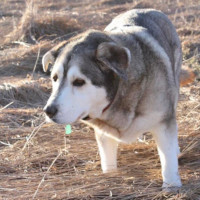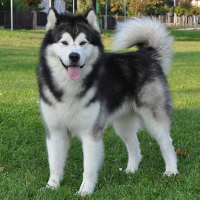Appearance of the Alaskan Malador
|
| As a hybrid that is not completely stabilized, the Alaskan Malador can inherit any combination of physical traits from its parent breeds. In general, however, this breed resembles a lean Labrador with Alaskan Malamute markings on face and body. It has a muscular body, with a moderately broad chest and slightly arched neck. It has pendulous ears like its Labrador parent and large almond-shaped eyes like its Alaskan Malamute parent, giving it a distinct Spitz appearance. Its eyes can be blue, hazel, brown or amber, and its coat can be a multicolored combination of colors common to both parents. In addition, the coat is dense and short, while the undercoat is soft and woolly. Alaskan Maladors often have prominent black markings around the face. Finally, the Alaskan Malador has large, heavily padded legs and a medium-length, full tail, with the possibility of feathering along the crest. |
Temperament of the Alaskan Malador
|
| Alaskan Maladors are energetic, outgoing dogs that enjoy the company of humans. They love to explore and are happiest when spending the day hiking or adventuring with their owners. The Labrador Retriever influence in this breed means that they are very people-centered, so much so that Alaskan Maladors are prone to separation anxiety. Owners can combat this problem to some extent by ensuring that their pet has a regular, balanced schedule. This hybrid is also highly intelligent and very easy to train; it is also very good at learning and performing tricks. Bear in mind, however, that restless and bored Alaskan Maladors can be unruly and destructive. What's more, Alaskan Maladors are everyone's friend: they adapt perfectly to multi-pet households and get on very well with children. They respond well to positive affirmation and affection. All in all, this large dog will adapt perfectly to an active lifestyle and a loving family home. |
Needs and activities of the Alaskan Malador
|
| This hybrid is known for its stamina, and loves vigorous exercise and activity. Both its parent breeds love outdoor adventures, and Alaskan Maladors are no exception. They enjoy strenuous hiking, swimming and outdoor play in wide-open spaces, possibly in the company of other dogs. As this is a very active dog, it needs 60 to 90 minutes of physical exertion a day. Alaskan Maladors are also highly intelligent, and enjoy learning tricks, commands and playing games with their owners indoors. Although this breed adapts to all types of climate, it thrives in rural or suburban environments where it has a yard and/or a large outdoor space in which to run. |
Maintenance of the Alaskan Malador
|
| Alaskan Maladors are not a hypoallergenic breed and are not suitable for pet owners suffering from allergies. Their coat is dense and sheds a lot, especially during seasonal changes. To a certain extent, owners can reduce shedding by brushing their pets daily with a pin brush, toothbrush or detangling brush. In addition, Alaskan Maladors should be bathed from time to time - no more than once every two months - to avoid drying out the natural oils in their coat. They should also have their hanging ears cleaned regularly, their teeth brushed daily to prevent dental problems, and their nails trimmed monthly to prevent painful growths. |









 English (United Kingdom)
English (United Kingdom)